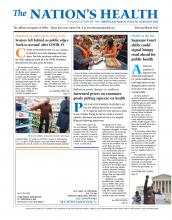After an avalanche of Supreme Court rulings that undermined U.S. public health last year, some legal experts are predicting the nation could be in for more of the same in coming months.
In 2022, justices upended abortion rights, supported firearm carrying in public places and roped in the federal government’s ability to enforce environmental regulations, among other decisions. This year, the court’s docket includes several cases with far-reaching public health impact, leaving some health advocates wary of what may be ahead.
“It becomes a line-drawing exercise about how far the court is willing to go,” said Lindsay Wiley, JD, MPH, professor of law and the director of the health law and policy program at the University of California-Los Angeles School of Law.

People protest outside the U.S. Supreme Court in September as arguments were heard in Moore v. Harper, a case on gerrymandering in North Carolina.
Photo by Olivier Douliery, courtesy AFP/Getty Images
The Supreme Court’s June decision to end the constitutional right to abortion had an immediate impact, as some states outlawed the procedure at various stages of pregnancy, leading to a health crisis for millions of women, said Sara Rosenbaum, JD, a professor of health law and policy at the George Washington University’s Milken Institute School of Public Health.
“We are facing a situation where essentially the Supreme Court has actively interfered in a really negative way with the standard of medical care itself, which is very frightening,” Rosenbaum, an APHA member, told The Nation’s Health. “I quite frankly don’t think it’s safe in about half the country now for somebody to get pregnant.”
Over 60% of Americans support abortion rights, according to a Pew Research Center poll last year. But public opinion does not seem to factor into some of the justice’s decisions, Wiley said.
“The new majority isn’t particularly swayed by political will or political consequences,” Wiley told The Nation’s Health. “It seems to be deeply ideological, the opposition to abortion rights for some of these justices in particular.”
Beyond its ideological leanings, the way the court evaluates U.S. law seems to have shifted as well. Weeks after horrific mass shootings in Texas and New York last year, the court struck down a New York law that restricted people from carrying guns in public. As they weighed their decision, justices looked at the way founders thought about guns in the 18th century, reasoning that the Second Amendment right to bear arms was meant to extend beyond the home and into the public sphere.

Activists protest a June Supreme Court ruling that the Environmental Protection Agency cannot issue broad limits on greenhouse gases, a driver of climate change.
Photo by Ed Jones, courtesy AFP/Getty Images
“In the past, the court had said, ‘We’re going to take historical analysis into account alongside balancing the government’s interest against the individual right now,’” Wiley told The Nation’s Health. “(But) today’s Supreme Court has said that historical analysis is really the only analysis that the court should be engaging in.”
Some lower court judges are now applying the Supreme Court’s litmus test of history and original meaning to state gun cases. In October, a West Virginia federal judge ruled that the federal ban on guns without serial numbers was unconstitutional because serial numbers were not used in 1791, when the Second Amendment was drafted.
The recent high-profile Supreme Court rulings followed a pattern by the court to limit federal agency power to the detriment of public health, legal scholars say. In summer 2021, the court’s majority struck down the federal eviction moratorium by the Centers for Disease Control and Prevention that helped renters stay in their homes after job displacement caused by the COVID-19 pandemic. In 2022, the court blocked a rule by the Occupational Safety and Health Administration that required 80 million workers to be vaccinated or periodically tested for COVID-19.
This year, the court is expected to rule on two cases involving affirmative action admission policies at U.S. universities, which have allowed more people of color to attend college, gain high-paying jobs and diversify the professional workforce, including the public health field.
If a majority of justices find in favor of the plaintiffs — who argue that race-conscious admissions violate the 14th Amendment’s edict of equal protection under the law — the effects could ripple far beyond universities, experts predict.
For example, environmental justice policies and programs that seek to improve health in specific vulnerable populations could be overturned. Among those under threat is a 2020 New Jersey law that requires state regulators to consider environmental and public health impacts in overburdened communities where at least 40% of residents are people of color.
Another Supreme Court case that could have far-reaching ramifications for public health is a suit brought by a resident of a corporation-owned long-term care facility. The corporation is asking the court to overturn rulings that allow facility residents to sue. If the request is granted, it could serve as precedent to deny legal remedies for beneficiaries of federal programs such as Medicaid and the Supplemental Nutrition Assistance Program, Rosenbaum said.
Losing the right to sue could hit some Medicaid beneficiaries particularly hard. Once the government-designated COVID-19 public health emergency that expanded access ends, they would have no legal remedy if they lost coverage.
“There’s a lot of concern that some states, rather than following the law, will, like a child sweeping chess pieces off a chessboard, sweep everybody away in a big hurry and without due process,” Rosenbaum said.
Taking action for public health
While the current Supreme Court makeup may not change for some time, there are ways to take action to support public health, legal experts say. Advocates can make their voice known through friend-of-the-court briefs, which are legal documents filed by experts who are not directly involved in a case. APHA frequently submits briefs in high-level court cases that impact public health, using its expertise, reputation and partnerships to weigh in on decisions.
Closer to home, states can pass their own public health laws, and voters can support public health-friendly ballot measures. In November, voters in California, Michigan and Vermont supported adding stronger abortion rights protections to their state constitutions.
Americans can also vote in public health-friendly leaders who appoint justices at the local and state level, where turnover is more frequent than in the high court. Putting pressure on national leaders is also effective.
“The president and Congress have vacancies to fill at all levels of the judiciary,” Jay Duffy, JD, an attorney with the Clean Air Task Force, told The Nation’s Health. “It is important that the appointees understand the importance of public health and regulations to protect it.”
To search the Supreme Court docket for past and pending cases, visit www.supremecourt.gov/docket.
- Copyright The Nation’s Health, American Public Health Association









